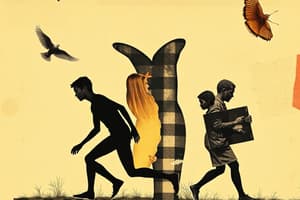Podcast
Questions and Answers
What is the term for the retention of juvenile characteristics in an organism?
What is the term for the retention of juvenile characteristics in an organism?
- Neoteny (correct)
- Metamorphosis
- Atavism
- Adaptation
What is the classic example of sequence heterochrony mentioned in the text?
What is the classic example of sequence heterochrony mentioned in the text?
- Axolotl (correct)
- Lystrosaurus
- Chimpanzee
- Salamander
What is the cause of the Cretaceous mass extinction event?
What is the cause of the Cretaceous mass extinction event?
- Volcanic eruptions
- Interruption to photosynthesis
- Meteor impact (correct)
- Changes in temperature
What is the term for changes in the appearance of different phenotypes at life stages when they normally would not occur?
What is the term for changes in the appearance of different phenotypes at life stages when they normally would not occur?
What is the current threat to amphibians mentioned in the text?
What is the current threat to amphibians mentioned in the text?
What is the term for the accelerated rate of extinction caused by human-induced causes?
What is the term for the accelerated rate of extinction caused by human-induced causes?
What is the term for the retention of juvenile characteristics in humans, such as retaining baby faces?
What is the term for the retention of juvenile characteristics in humans, such as retaining baby faces?
What is the term for the phenomenon where the extinction rate tends to track with human population growth rate?
What is the term for the phenomenon where the extinction rate tends to track with human population growth rate?
What is the term for the biomass decrease of insects by 76% in 30 years in Germany?
What is the term for the biomass decrease of insects by 76% in 30 years in Germany?
What is the term for the event that involves a global extinction event killing roughly greater than 50% of species on the planet?
What is the term for the event that involves a global extinction event killing roughly greater than 50% of species on the planet?
What is the gradualistic model in evolutionary biology based on?
What is the gradualistic model in evolutionary biology based on?
What is the punctuated equilibrium model in evolutionary biology characterized by?
What is the punctuated equilibrium model in evolutionary biology characterized by?
What is an example of the punctuated equilibrium model?
What is an example of the punctuated equilibrium model?
What is sympatric speciation?
What is sympatric speciation?
Why is the gradualistic model and the punctuated equilibrium model considered wrong?
Why is the gradualistic model and the punctuated equilibrium model considered wrong?
What is the tempo of evolution in the punctuated equilibrium model characterized by?
What is the tempo of evolution in the punctuated equilibrium model characterized by?
What is an example of the tempo of evolution in the gradualistic model?
What is an example of the tempo of evolution in the gradualistic model?
What is the tempo of speciation in the punctuated equilibrium model characterized by?
What is the tempo of speciation in the punctuated equilibrium model characterized by?
What is the tempo of phenotypic change in the gradualistic model based on?
What is the tempo of phenotypic change in the gradualistic model based on?
What is an example of a species that has been around for a very long time?
What is an example of a species that has been around for a very long time?
What is anagenesis?
What is anagenesis?
What is an example of sympatric speciation?
What is an example of sympatric speciation?
What can be altered by a single point mutation, resulting in a complete reconfiguration of the body plan?
What can be altered by a single point mutation, resulting in a complete reconfiguration of the body plan?
What is heterochrony?
What is heterochrony?
What is the primary reason for the high value of horseshoe crab blood?
What is the primary reason for the high value of horseshoe crab blood?
What is cladogenesis?
What is cladogenesis?
What can natural selection work on?
What can natural selection work on?
What is an example of allometric heterochrony?
What is an example of allometric heterochrony?
Is the gradualistic model based on the idea of regular, slow phenotypic change occurring at a roughly constant rate that leads to new species?
Is the gradualistic model based on the idea of regular, slow phenotypic change occurring at a roughly constant rate that leads to new species?
Is the punctuated equilibrium model characterized by long periods of stasis with no change, followed by big adaptive radiation, and then no change again?
Is the punctuated equilibrium model characterized by long periods of stasis with no change, followed by big adaptive radiation, and then no change again?
Is the example of cichlid fishes occurring in African Lake Victoria potentially an example of sympatric speciation?
Is the example of cichlid fishes occurring in African Lake Victoria potentially an example of sympatric speciation?
Sympatric speciation in plants commonly occurs through polyploidy, where a genome duplication event leads to the formation of a new species.
Sympatric speciation in plants commonly occurs through polyploidy, where a genome duplication event leads to the formation of a new species.
HOX genes can be altered by a single point mutation, resulting in a complete reconfiguration of the body plan.
HOX genes can be altered by a single point mutation, resulting in a complete reconfiguration of the body plan.
Examples of heterochrony include allometric heterochrony, which is difficult to measure due to occurring early in development and a long time ago.
Examples of heterochrony include allometric heterochrony, which is difficult to measure due to occurring early in development and a long time ago.
Neoteny refers to the retention of adult characteristics in an organism?
Neoteny refers to the retention of adult characteristics in an organism?
The accelerated rate of extinction is a natural part of life and has been well-documented in the fossil record?
The accelerated rate of extinction is a natural part of life and has been well-documented in the fossil record?
The axolotl is an example of sequence heterochrony because it retains its external gills into adulthood?
The axolotl is an example of sequence heterochrony because it retains its external gills into adulthood?
The biomass of insects in Germany has increased by 76% in 30 years?
The biomass of insects in Germany has increased by 76% in 30 years?
Flashcards are hidden until you start studying
Study Notes
Horseshoe Crabs, Evolution, and Speciation
- Horseshoe crabs have undergone minimal change despite facing various environmental challenges and predators.
- Horseshoe crab blood is highly valuable due to its immune properties, fetching a price of 60-80k per gallon and is used in vaccine development.
- The visual representation compares gradualism, where small regular changes lead to new species, to the punctuated equilibrium model, where rapid bursts of change occur.
- Anagenesis refers to gradual evolution from one species to the next, while cladogenesis involves branching off into two or more species.
- The rate of speciation is influenced by factors such as mutation rate, strength of natural selection, generation time, and environmental change.
- Natural selection can work on existing structures, as seen in the evolution of the eel's jaws and the fish's lure.
- Sympatric speciation in plants is common, often through polyploidy, where a genome duplication event leads to the formation of a new species.
- HOX genes can be altered by a single point mutation, resulting in a complete reconfiguration of the body plan.
- Heterochrony, involving changes in the timing or sequence of development, can impact rates of speciation and lead to different phenotypes.
- Examples of heterochrony include allometric heterochrony, which is difficult to measure due to occurring early in development and a long time ago.
- Domesticated dogs exemplify allometric heterochrony, showing changes in size through time compared to their wolf ancestors.
- Heterochrony can lead to phenotypic changes that contribute to differential reproductive success, shaping evolutionary patterns.
Horseshoe Crabs, Evolution, and Speciation
- Horseshoe crabs have undergone minimal change despite facing various environmental challenges and predators.
- Horseshoe crab blood is highly valuable due to its immune properties, fetching a price of 60-80k per gallon and is used in vaccine development.
- The visual representation compares gradualism, where small regular changes lead to new species, to the punctuated equilibrium model, where rapid bursts of change occur.
- Anagenesis refers to gradual evolution from one species to the next, while cladogenesis involves branching off into two or more species.
- The rate of speciation is influenced by factors such as mutation rate, strength of natural selection, generation time, and environmental change.
- Natural selection can work on existing structures, as seen in the evolution of the eel's jaws and the fish's lure.
- Sympatric speciation in plants is common, often through polyploidy, where a genome duplication event leads to the formation of a new species.
- HOX genes can be altered by a single point mutation, resulting in a complete reconfiguration of the body plan.
- Heterochrony, involving changes in the timing or sequence of development, can impact rates of speciation and lead to different phenotypes.
- Examples of heterochrony include allometric heterochrony, which is difficult to measure due to occurring early in development and a long time ago.
- Domesticated dogs exemplify allometric heterochrony, showing changes in size through time compared to their wolf ancestors.
- Heterochrony can lead to phenotypic changes that contribute to differential reproductive success, shaping evolutionary patterns.
Studying That Suits You
Use AI to generate personalized quizzes and flashcards to suit your learning preferences.



